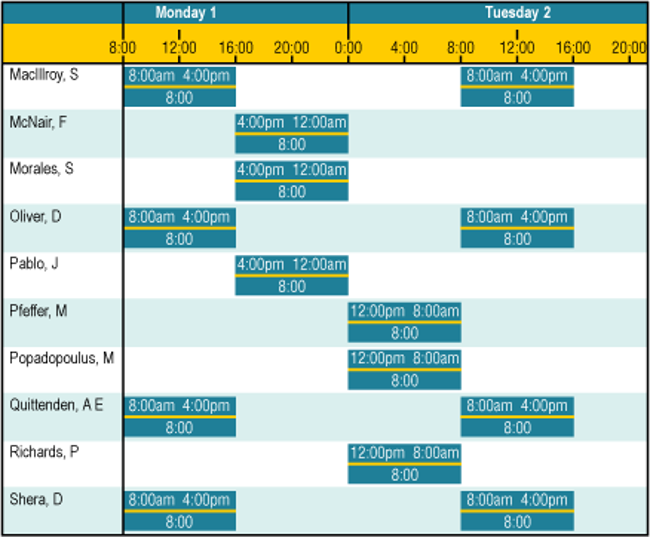An action plan is a simple tool that will help you work out:
- what tasks need to be done to achieve a goal
- who does each task
- when they do it.
By developing an action plan you focus on what you want to achieve. You will also need to prioritise or determine in what order tasks will be done, when each task will be completed, how each task will be done, and how its achievement will be measured.
Here’s an example of an action plan for a team:
Goal: To launch a new product in stores.
| Item no | Action | Who | By when | Progress |
| 1 | Prepare the sales targets | Jenny | 30 Aug | |
| 2 | Prepare the staffing plan | Dennis | 15 Sept | |
| Recruit new staff | Dennis | 15 Oct | ||
| 3 | Provide induction and product training | Ian | 30 Oct |
Sometimes you will need a more detailed schedule than a simple action plan, especially if you have several people working on the job.
A schedule shows you:
- when each task begins and ends
- who is doing it
- how much time (actual work) is allocated for the task (or the person who is doing it).
A sample schedule for a work team:

If this was a schedule for your work team, how will it help you?
- It will prevent people and equipment being idle in one area while things are busy in another. Look at the example above. It shows us that if Dennis needs more help with the staffing and recruitment tasks, Ian may be available to help out.
- It will help to make sure that when people are ready to start their task, another task that needs to happen first has been completed. Look at the example again — how could Ian train the new staff if Dennis has not recruited them?
- It will help you make good decisions. You will avoid putting off important jobs because other things will have lower priorities. Look at the example — what would you say to Jenny if she asked for leave during August?
Other things you may need to know for your work team's schedules are:
- details of the task involved
- estimates of the time needed to complete the activity
- number of items or services to be completed within a time-frame
- number and type of machines and/or staff need to complete the task
- external and internal factors that may influence how well your team can perform.
My workplace
What action plans or schedules do you use? Do you use business technology for this, e.g. scheduling or calendar software?
Another resourcing skill required by frontline managers is the skill of rostering or scheduling staff. Rosters are systematic schedules which outline the assignments, shifts or duties of individuals within an organisation. They typically include information such as names, dates and times and are a vital tool to help allocate resources efficiently within an organisation by ensuring the right people are given the necessary tasks and responsibilities needed to carry out the business operations effectively.
Effective rostering requires:
- knowledge of the staffing requirements of the operational plan
- knowledge of staff availability
- understanding of the relevant industrial awards or agreements that govern scheduling activities.
Rosters help managers to calculate the number of staff they’ll need by showing the human resourcing requirements over a period of time, and are used by both managers and staff to check start and finish times. Many organisations have paper-based or electronic forms that are used to design and communicate a staffing roster.
A roster that includes night work (e.g. a security company, hotel or emergency service):

- Reviewing a personal work schedule involves seeking and evaluating feedback on actual work performance, analysing variations between expected and actual work performance, and updating personal work schedule to accommodate any changes.
- Feedback provides a variety of perspectives on actual work performance. It is usually composed of a person's highlights, lowlights, and areas of improvement when performing a work task.
- Evaluating feedback is necessary to determine its overall effect on work performance. Feedback should be evaluated according to influence, validity, and reliability.
- Analysing variations between expected and actual work performance involves self-assessment using all the data that has been gathered during planning and implementation.
- Self-assessment should end with a set of goals and corresponding action items that aim to address the variations that have been documented.
- Changes in your personal work schedule will occur to accommodate the action items. These changes, when properly implemented, will ensure that assigned work tasks will be completed successfully in a timely manner.
- Action plans are simple tools to help you work out which tasks need to be done, who needs to do them and when they need to do them.
- Schedules and rosters are resourcing skills necessary to help frontline managers organise personnel needed to help in achieving an organisation’s business goals.
Now it’s your turn
Prior to moving on to the next topic, have a conversation with someone that is not in Human Resources or studying this qualification and in your own words:
- Describe a project you would need an action plan for.
- Describe the type of schedules or rosters for different departments in your workplace.
- Explain how you could add technology to help manage scheduling staff..
